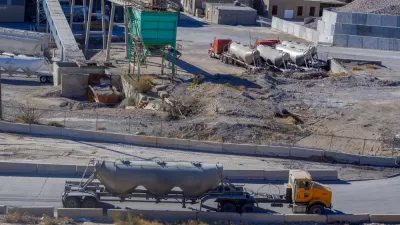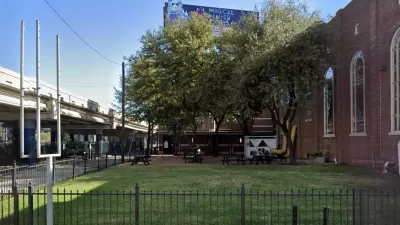Houston doesn't compare well with other cities when it comes to locating polluting industrial uses near residential neighborhoods. Blame the city's lack of zoning, according to new research.

"If you read [the Houston Chronicle's] Chemical Breakdown series on the poor oversight of Houston's repositories of toxic material, you already know that potentially dangerous stuff could be lurking in your backyard," according to an article by Lydia DePillis.
But the poor regulation of polluters in only half of a uniquely Houstonian threat: "That might be more common than it is in other Texas cities, according to a new analysis, because of Houston's longstanding resistance to zoning."
The new analysis DePillis mentions is contained in a working paper by economists at the University of Pittsburgh and the University of Washington, which examines the influence of zoning in the city of Chicago and several Texas cities.
Judging by the distribution of toxics-emitting facilities on a list maintained by the Environmental Protection Agency — which you can see for Houston here — the economists did find that polluters tend to be more densely clustered in other large Texas cities with fairly traditional zoning codes. In Houston, 65 percent of the city is within one mile of a facility in the toxic release inventory. That number is 30 percent, 44 percent, and 43 percent for Austin, San Antonio, and Dallas respectfully.
As for why economists were compelled to chime in on matters of land use regulation, DePillis notes that homes near sources of pollution tend to have lower property values. Therefore, huge swaths of Houston are less valuable than they might have been if zoning had separated polluting industrial uses out from residential areas.
FULL STORY: How zoning impacts your proximity to pollution

Alabama: Trump Terminates Settlements for Black Communities Harmed By Raw Sewage
Trump deemed the landmark civil rights agreement “illegal DEI and environmental justice policy.”

Study: Maui’s Plan to Convert Vacation Rentals to Long-Term Housing Could Cause Nearly $1 Billion Economic Loss
The plan would reduce visitor accommodation by 25% resulting in 1,900 jobs lost.

Planetizen Federal Action Tracker
A weekly monitor of how Trump’s orders and actions are impacting planners and planning in America.

Wind Energy on the Rise Despite Federal Policy Reversal
The Trump administration is revoking federal support for renewable energy, but demand for new projects continues unabated.

Passengers Flock to Caltrain After Electrification
The new electric trains are running faster and more reliably, leading to strong ridership growth on the Bay Area rail system.

Texas Churches Rally Behind ‘Yes in God’s Back Yard’ Legislation
Religious leaders want the state to reduce zoning regulations to streamline leasing church-owned land to housing developers.
Urban Design for Planners 1: Software Tools
This six-course series explores essential urban design concepts using open source software and equips planners with the tools they need to participate fully in the urban design process.
Planning for Universal Design
Learn the tools for implementing Universal Design in planning regulations.
Caltrans
Smith Gee Studio
Institute for Housing and Urban Development Studies (IHS)
City of Grandview
Harvard GSD Executive Education
Toledo-Lucas County Plan Commissions
Salt Lake City
NYU Wagner Graduate School of Public Service





























